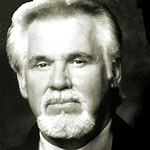The term “multi-talented” often becomes overused even misused in the show business lexicon, so often employed in the context of an individual’s talents. Not so in the case of Kenny Rogers, whose career embodied many of the attributes most often associated with Lifetime Achievement.
Over the course of his long and productive career, Rogers excelled as an entertainer… a star interpreter of the great songs by the great songwriters, a television and motion picture star, and as both businessman and benefactor…a frequent dispenser of funds to help alleviate the pain of many kinds of neediness.
Born in Houston, Rogers, the owner of many forms of accolades for his music performances on recordings and in concerts, was an active player on the great stage of entertainment. As a child, he was a resident of Federally-funded housing in Houston, with seven siblings. An example of his entrepreneurship occurred during his earlier middle school period; he was making extra money selling newspapers on a busy Houston street corner. At one point, he was able to sell the route to a friend, collecting a royalty from the other boy for each paper sold.
As a late teenager and into his 20s, Rogers was able to parlay a strong natural feeling for music with his powerful innate knowledge of rhythm and blues, pop, jazz and country music. He seemed to enjoy a natural fit into all these genres, always popular then and certainly now as well.
Rogers’ very first professional group was a late 1950s vocal act known as The Scholars which scored several local Houston hits, including “That Crazy Feeling” on the Carlton label, earning him, at age 20, a shot on Dick dark’s American Bandstand.
During the early ‘60s, he developed a feel for studio techniques and musical sophistication as he played bass and occasionally did vocals with a Houston jazz group, The Bobby Doyle Three. Later he enjoyed membership in a folk ensemble known as The New Christy Minstrels, which gave rise to Kenny Rogers and the First Edition, a band founded with other Minstrel alumni with a repertoire of folk, rock and country material. The First Edition hit big in the late ‘60s with the novelty psychedelic opus, “Just Dropped In (to See what Condition my Condition Was In),” which helped spur a variety television series for the group, taped in the CTV Studios in Toronto. Following the demise of the First Edition in the mid-‘70s, Rogers signed on with United Artists Records, a link-up which produced a series of major hits, including the stunningly successful ballad, “Lucille,” which ultimately crossed over to hit the number 5 slot on Billboard’s Hot 100 (Pop) Chart.
For the next decade, Rogers enjoyed a collection of hits, virtually every time out on United Artists and later its companion Liberty label, including such memorable titles as “The Gambler,” “She Believes in Me,” “Coward of the County” and the incredible smash, “Lady,” the latter written by the Commodores’ Lionel Richie, himself an inductee into the Songwriters’ Hall of Fame.
During the ‘80s, Rogers continued his unbroken chain of hits, many of them strongly pop-tinged, including the memorable “I Don’t Need You,” “Love Will Turn You Around,” “Crazy,” “Real Love,” the George Martin-produced, “Morning Desire” and “Tomb of the Unknown Love.”
Duet smashes also dot the Kenny Rogers career, beginning with Dottie West with “Every Time Two Fools Collide,” “All I Ever Need Is You” and “What Are We Doin’ In Love?” With singer/songwriter Kim Carnes, it was “Don’t Fall in Love with a Dreamer” and “You’re a Part of Me,” while a teaming with Sheena Easton resulted in another major hit. “We’ve Got Tonight.” One of the most memorable of all was the duet with Dolly Parton, “Islands in the Stream,” and still later, Rogers recorded “Make No Mistake, She’s Mine,” with the then hot country singer, Ronnie Milsap.
The earlier album, “The Gambler,” later spawned a brand new acting career for Rogers with a series of five highly-rated made-for-television treatments.
Beyond his demanding recording and concert schedules, Kenny Rogers found time to build a major investment in the country mecca of Branson, Missouri, producing a successful clothing line, engaging in significant philanthropic endeavors, and utilizing his long time hobby of photography, publishing several well-received books of his works.
Rogers received many citations and special awards, including one of his most prized, The Horatio Alger Award, presented annually to a small group of men and women who have overcome hardship in their personal lives and gone on to success through hard work and impeccable integrity. Rogers was named for a similar accolade by the U.S. Department of Housing and Urban Development. As an active spokesman for World Hunger, Rogers took over much of the ongoing work of his friend, the late Harry Chapin. He also participated in “We Are the World,” the multi-celebrity performance on record that raised millions for famine relief in Africa, and served as co-chair with manager Ken Kragen, of the notable “Hands Across America” event, which again called attention to the problem of world hunger.
Another major career project for Kenny Rogers came during the Christmas period of 1998 when he starred in a special six-week off-Broadway run on New York’s Upper West Side at the historic Beacon Theater of “Christmas from the Heart.” The musical was based on an original story by Rogers and Kelly Junkerman and was presented by Hallmark Entertainment.
Rogers sold nearly 100 million records world-wide, and had won four Grammys, 11 People’s Choice awards, five Country Music Association awards and eight Academy of Country Music awards. He had 19 platinum albums (eight are multi-platinum), one platinum single and as one biographer put it, “enough gold albums and singles to stock Fort Knox.” He also won the prized diamond award from the Record Industry Association of America (RIAA) for sales in excess of 10 million units for his “Greatest Hits” album.


